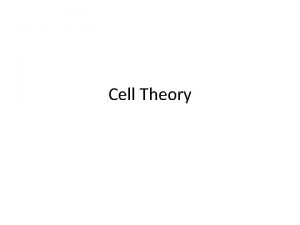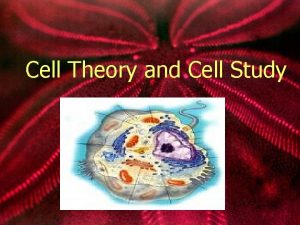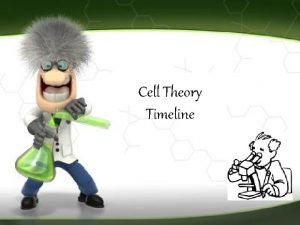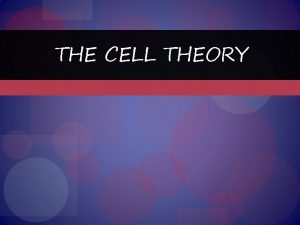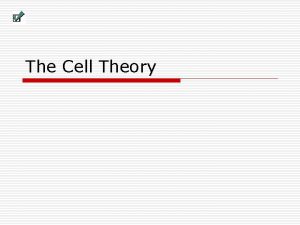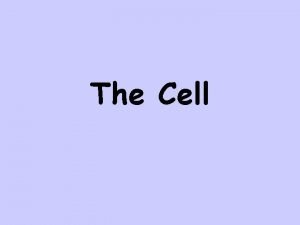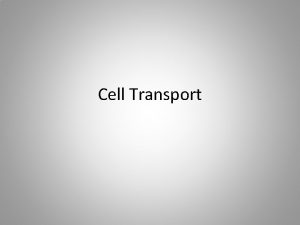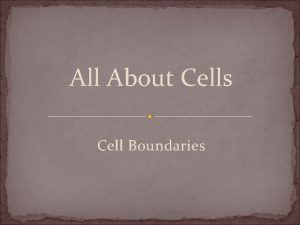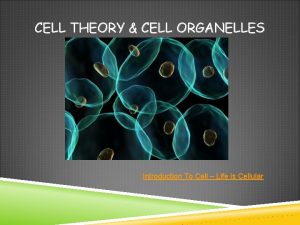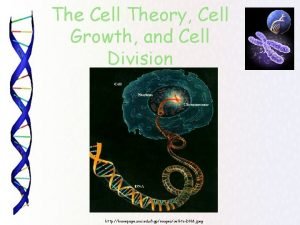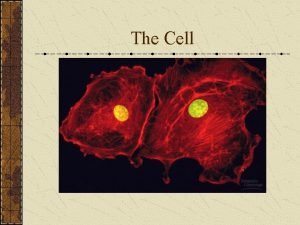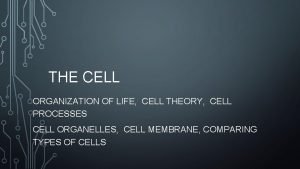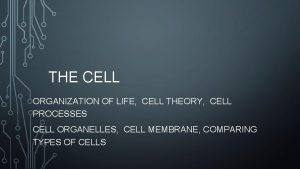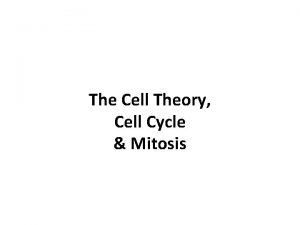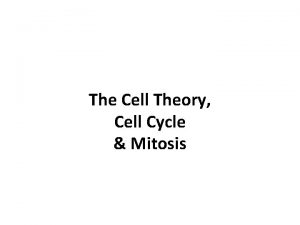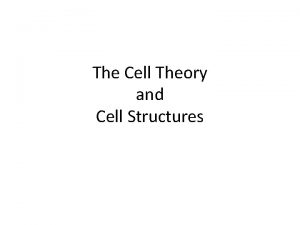What is the Cell Theory Cell Theory All







































- Slides: 39

What is the Cell Theory? • Cell Theory: – All living things are composed of cells – Cells are basic unit of structure and function in living things – All cells come from preexisting cells

What are the 2 major classes of cells?

What are the 2 major classes of cells? • Prokaryotic: – Lack nucleus/most other organelles – Occur earliest in history of life – Examples? • Bacteria • Eukaryotic: – Has nucleus/other organelles – Examples? – Animal/plant/fungi/protists

What are the 2 major classes of cells?

What are the similiarities between animal/plant cells?

What are the similiarities between animal/plant cells? • Organelle: – Each part of cell that has a specific function – Plasma membrane: • Thin outer covering • Defines boundary of cell and regulates traffic of chemicals between the cell and its surroundings – Nucleus: • Holds genetic information – Cytoplasm: • Region between nucleus and plasma membrane (fluid like)

What are the similiarities between animal/plant cells? – Mitochondria • Supplies cell energy (ATP) – Endoplasmic Reticulum • Protein translation/protein transport – Golgi Apparatus • Processes and package macromolecules – Vacuoles • storage

What are the similiarities between animal/plant cells?

What are the differences between animal/plant cells? • Chloroplasts: – Organelle that is the site of photosynthesis • Cell Wall: – Protects cell and holds shape

• What molecules make up a cell membrane? • What is unique about the interaction of lipids and water? • Why do lipids work well for a cell’s boundary, given the fluid inside and surrounding cells?

What is the function of a cell membrane? • Keeps the cell organized • Regulates flow of material

What is membrane structure? • Made up mostly of proteins and lipids • Phospholipid: – 2 fatty acid TAILS – 1 Head

Biological Membranes are Bilayers two layers of lipids each layer has hydrophillic portion hydrophobic portion inside associated with other fatty acids

Hydrophillic Region Hydrophobic Region Hydrophillic Region

Biological Membranes have a lot of lateral mobility “fluid mosaic”


Functions of Membrane Proteins • Connection to other cells • Transport molecules across membrane • Membrane associated enzyme activity


How do molecules cross a membrane? • Passive Transport – Movement of molecules across a membrane without input of energy – Molecules move from high concentration to low concentration • Active Transport – Movement of molecules across a membrane with input of energy – Molecules move from low concentration to high concentration

What is passive transport? • Some membranes are selectively permeable – some molecules can cross easily, some molecules cannot • Passive Transport: – Diffusion across a membrane – No energy is required – Oxygen/carbon dioxide

There is energy in concentration gradients Molecules always diffuse from areas of high concentration to low

What are examples of passive transport? • Diffusion: – The net movement of particles from an area of high concentration to low concentration – Produces equilibrium


What is Osmosis? • Osmosis: – Passive transport of water from high concentration to low concentration – Hypertonic • when solution has higher concentration of solute than the cell – Hypotonic • When the solution has a lower concentration of solute than the cell – Isotonic • When the solution has equal concentration of solute than the cell (equilibrium) Where will water move into the cell or out of cell?




Water diffuses from areas of high concentration to low lots of external solutes little external solutes

Membranes are semi-permeable Some molecules can cross membrane, many can’t More hydrophobic molecules can cross membrane more easily

What is facilitated diffusion? • Facilitated Diffusion: – Transport proteins embedded in membrane provide a pathway for certain molecules to pass – Water, sugars


Proteins act as portals Many molecules can’t get across on their own Protein channels allow specific molecules to cross

What is Active Transport? • Active Transport: – Requires energy to transport molecules across a membrane – A transport protein pumps molecules across membrane, usually against concentration gradient – Opposite way than diffusion – THE TRANSPORT PROTEIN RECOGNIZES CERTAIN MOLECULES (SOLUTES). WHAT OTHER PROTEIN HAS THIS TYPE OF RECOGNITION? – Enzymes!!!!

Active Transport ATP ADP Use ATP to move molecules against their concentration gradient


How do large molecules cross membranes? • Vesicles: – Small membrane sacs – Hold large molecules to open up into cell or out of cell

How do large molecules cross membranes? • Exocytosis: – Vesicle expels contents out of cell • Endocytosis: – Vesicle takes material into cell by budding into cell


Endocytosis
 Name three line segments
Name three line segments Chapter 4 cell theory and cell study
Chapter 4 cell theory and cell study Hát kết hợp bộ gõ cơ thể
Hát kết hợp bộ gõ cơ thể Frameset trong html5
Frameset trong html5 Bổ thể
Bổ thể Tỉ lệ cơ thể trẻ em
Tỉ lệ cơ thể trẻ em Voi kéo gỗ như thế nào
Voi kéo gỗ như thế nào Chụp tư thế worms-breton
Chụp tư thế worms-breton Alleluia hat len nguoi oi
Alleluia hat len nguoi oi Các môn thể thao bắt đầu bằng tiếng nhảy
Các môn thể thao bắt đầu bằng tiếng nhảy Thế nào là hệ số cao nhất
Thế nào là hệ số cao nhất Các châu lục và đại dương trên thế giới
Các châu lục và đại dương trên thế giới Công của trọng lực
Công của trọng lực Trời xanh đây là của chúng ta thể thơ
Trời xanh đây là của chúng ta thể thơ Mật thư tọa độ 5x5
Mật thư tọa độ 5x5 101012 bằng
101012 bằng độ dài liên kết
độ dài liên kết Các châu lục và đại dương trên thế giới
Các châu lục và đại dương trên thế giới Thể thơ truyền thống
Thể thơ truyền thống Quá trình desamine hóa có thể tạo ra
Quá trình desamine hóa có thể tạo ra Một số thể thơ truyền thống
Một số thể thơ truyền thống Cái miệng nó xinh thế
Cái miệng nó xinh thế Vẽ hình chiếu vuông góc của vật thể sau
Vẽ hình chiếu vuông góc của vật thể sau Thế nào là sự mỏi cơ
Thế nào là sự mỏi cơ đặc điểm cơ thể của người tối cổ
đặc điểm cơ thể của người tối cổ V cc
V cc Vẽ hình chiếu đứng bằng cạnh của vật thể
Vẽ hình chiếu đứng bằng cạnh của vật thể Fecboak
Fecboak Thẻ vin
Thẻ vin đại từ thay thế
đại từ thay thế điện thế nghỉ
điện thế nghỉ Tư thế ngồi viết
Tư thế ngồi viết Diễn thế sinh thái là
Diễn thế sinh thái là Các loại đột biến cấu trúc nhiễm sắc thể
Các loại đột biến cấu trúc nhiễm sắc thể Thế nào là số nguyên tố
Thế nào là số nguyên tố Tư thế ngồi viết
Tư thế ngồi viết Lời thề hippocrates
Lời thề hippocrates Thiếu nhi thế giới liên hoan
Thiếu nhi thế giới liên hoan ưu thế lai là gì
ưu thế lai là gì Hươu thường đẻ mỗi lứa mấy con
Hươu thường đẻ mỗi lứa mấy con








































